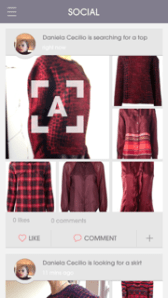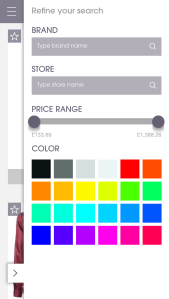Fashion has been one of the most promising and most dynamic categories of e-commerce in the past several years. But it has also been one of the most problematic. Thanks to virtuality, we now have at our fingertips more choices for what to buy and wear than ever before. But that also means a predicament: with infinite variety on offer, how do you sift through that to find the things you really want to buy?
 Asap54, an app and startup launching today as part of the Startup Battlefield at TechCrunch Disrupt Europe in Berlin, is proposing an answer to that question: find clothes that you like around you in the physical world, take a picture of them with you phone, and let Asap54 find you that exact piece, along with a bunch of others that are similar, so that you can get started. Think of it as a Shazam for fashion.
Asap54, an app and startup launching today as part of the Startup Battlefield at TechCrunch Disrupt Europe in Berlin, is proposing an answer to that question: find clothes that you like around you in the physical world, take a picture of them with you phone, and let Asap54 find you that exact piece, along with a bunch of others that are similar, so that you can get started. Think of it as a Shazam for fashion.
The concept is actually a well-tested and popular one in the analog world: fashion magazines high and low love to present candid street style pictures with subsequent dissections for readers about how and where to “get the look.” Asap54 — a play on getting your information “as soon as possible” and the slick street style of legendary fashion-forward New York disco club Studio 54 — is taking that basic concept and applying tech smarts to take it into the 21st century.
Working with a PhD in photo recognition and machine learning called Daniel Heesch (who had also co-founded another image recognition company called Pixsta), and 20 other engineers, Asap54 has created algorithms that identify clothes as well as fabrics.
 It then lets the user look specifically for the item in question, or change up some of the parameters — for example the colors; the article of clothing from, say, a shirt to a dress; the price; or selecting a specific designer. The results are presented in a picture-based list, and the user buys not directly from Asap54, but from specific online stores, with Asap54 collecting an affiliate fee in the process.
It then lets the user look specifically for the item in question, or change up some of the parameters — for example the colors; the article of clothing from, say, a shirt to a dress; the price; or selecting a specific designer. The results are presented in a picture-based list, and the user buys not directly from Asap54, but from specific online stores, with Asap54 collecting an affiliate fee in the process.
Then, if you are still not happy with the algorithmically generated results, you can also select an option to get a human fashion expert to analyse your picture and make suggestions; or you can turn to Asap54’s social network, a place where the Asap54 community can post pictures to crowdsource suggestions for pieces that are exactly the same or similar. “‘Never let the user down,’ is what we consider our motto,” founder Daniela Cecílio tells me.
There are a number of companies actively looking at ways of using image recognition to make fashion discover easier. They include startups like Pounce and Snapfashion but also established players like eBay. What sets Asap54 apart from the crowd is its very mobile-first approach — first as an iPhone app, then soon to come to iPad and Android. The other is the fact that it can be used on clothes on the go. (Pounce focuses on printed pictures in magazines and newspapers; eBay on its own site.)
On top of the companies that are already working on similar solutions, there are a number of others that you can imagine are probably looking at products like this, if not already developing them internally.
They include the likes of Pinterest, which just last week inked a deal with Getty Images to use its metadata to tag Getty pictures and then use that to provide other related pins to users. As the site looks further into commercialising its service, you can imagine how the company might use technology like this to lead users to more engagement and commerce via their platform.
Then you have Instagram. The company, now owned by Facebook, is going big on the fashion vertical, which has found a very natural affinity with the image-sharing network. Many designers already use it as a (free) marketing vehicle, Kevin Systrom pointed out in September, when he was in London for London Fashion Week. At the same time, he also pointed out that a big issue for the company will be to work out the best way to monetize that connection without annoying loyal and avid users.
While “Buy now!” buttons are probably not in the cards, could there be slick link between users’ candid snaps of cool clothes and then buying those pieces? It does seem much more plausible. It shouldn’t be forgotten that Facebook also owns some very powerful image recognition technology of its own, by way of Face.com.
Yes, this spells competition for Asap54, but also opportunity (and customers, and maybe even an exit somewhere). This is where execution will come into the game.
[gallery ids="906760,906761,906762,906763,906764,906765,906766"]
Cecílio, the Brazilian founder of Asap54, is not your average fashionista entrepreneur. She is the ex-COO of the hip fashion portal Farfetch (a marketplace for boutiques and designers) where she helped build out the company’s business in key markets like her native country. And there is something else: she’s actually the wife of Farfetch’s founder, Jose Neves.
I asked Cecilio why she decided to go out on her own to start Asap54 rather than figure out how to develop it within Farfetch itself. The answer was simple: she wanted her own thing, and she also thinks that it’s not always best to work with your significant other (note: from personal experience, I agree). He seemed to like the idea of her going out on her own for business: he’s also one of her backers.
There is also the fact that Asap54 goes beyond what Farfetch does: it has the potential to become a portal for shopping across many sites. Quite a fashionable lady herself, Cecilio told me that she woke up one night consumed by the idea that she needed an app just like this one. I mentioned that it seems once you have texture and shape nailed, there is no reason not to take it to other areas, like home furnishings or for non-ecommerce purposes in areas like industrial design or other enterprise purposes. She says that she’s sticking to what she knows and feels most passionate about; but there may be plans down the line for white-labelling.
Cecilio says that initially, Asap54 will launch in a limited beta to 200 users to test drive the service before a proper launch later this year. For now, check back in a bit to see a demo of the service in a video embed.